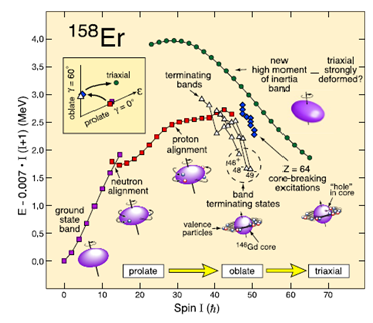A.J. Boston, H.C. Boston, L.J. Harkness-Brennan, P.J. Nolan, E.S. Paul,
The evolution of nuclear structure to extreme values of angular momentum continues to provide fascinating and surprising results. Our work at the extremes of angular momentum probes competing modes of nuclear excitation and the rich variety of shapes that can occur.

Over the past decade, two exotic nuclear-structure features have captivated the interests of both experimentalists and theorists in the heavy (mass 160) rare-earth region of the nuclear chart. One is the observation of ultrahigh-spin bands [1], which elucidate the highest angular momentum ever observed in a quantum system (70ħ) [2]. The other is evidence for a wobbling mode of rotation that is associated with the rotation of an asymmetrically shaped object [3].
Nuclear wobbling motion was initially discussed by Nobel Prize winners Bohr and Mottelson, who showed that this type of rotation can only occur for a triaxially deformed nuclear shape with distinct long, short, and intermediate principal axes. In this wobbling mode the nucleus rotates around the principal axis having the largest moment of inertia and this axis executes harmonic oscillations (precesses) about the space-fixed angular momentum vector. Its analogue in classical mechanics is the motion of an asymmetric top. Our work has established such nuclear wobbling motion in lighter mass 130 [4] and mass 100 [5] nuclei.
Our lifetime measurements of states in the ultrahigh-spin bands of the mass 160 region imply that they possess unexpectedly large quadrupole deformations [6.7]. Indeed, these bands have been interpreted to correspond to the rotation of an elongated triaxial nucleus with enhanced deformation [6-8]. Thus it is possible that these triaxial nuclei can wobble at ultrahigh spin and this is indeed the focus of our future research using the next generation of highly efficient multidetector gamma-ray spectrometers such as AGATA and GRETA.
[1] E.S. Paul, P.J. Twin, A.O. Evans, M.A. Riley, J. Simpson, et al., Phys. Rev. Lett 98, 012501 (2007).
[2] A.V. Afanasjev, Y. Shi, W. Nazarewicz, Phys. Rev. C 86, 031304 (R) (2012).
[3] S.W. Odegard, et al., Phys. Rev. Lett. 86, 5866 (2001).
[4] J.T. Matta et al., Phys. Rev. Lett. 114, 082501 (2015).
[5] J. Timar et al., Phys. Rev. Lett. 122, 062501 (2019).
[6] X. Wang et al., Phys. Lett. B 702, 127 (2011).
[7] J.P. Revill et al., Phys. Rev. C 88, 031304(R) (2013).
[8] Yue Shi et al., Phys. Rev. Lett. 108, 092501 (2012).